In addition to the more easily available English meals that you can take to work to warm up in the microwave oven, you can also create a number of real meals using Asian and other ingredients. This page tells you about them, what to do with them and what you can do if you can't get them.
Many Asian ingredients have a number of different names, simply because: the area is big enough to have a number of languages (Hindi and Punjabi come a close second to English where I live); and, these ingredients have been around long enough to evolve their own identities in various local cultures.
For example, one person suggested that I tried Lauki, the local supermarket sold Doodhi, another person hadn't heard of either but knew it as Kaddoo and that was what it was in the local Asian supermarket (at roughly the same price coincidentally).
Ideally, you should use the ingredients described below but if you cannot obtain them, alternatives are suggested. Flags show which supermarkets you are likely to get these ingredients from although many are becoming more generally available as time goes on.
 |
Green cardamom pods and seeds
|
In addition to the big-brand English supermarkets such as Tesco, ASDA and Sainsburys, there are also a number of supermarkets locally to where I live, that cater for the local south, south east and east Asian communities in the area.
I have found that prices overall are a bit lower in the Asian supermarkets but in some lines (popular, well-known-of ingredients such as soy sauce for example) the Asian supermarkets are substantially cheaper and, if you look at the ingredient lists on the labels, they are a lot better as well.
If you are lucky enough to live with such a diverse population, you will also have immediate access to these. Failing that, you can get good supplies of these over the internet or use substitutes for must-have ingredient-types - such as soy sauce, Mr Naga and so on - where there is no alternative other than moving to Derby in England.
Finally, for each of the items listed below, 




 indicates the type of shop you will probably find them at -
indicates the type of shop you will probably find them at -  vegan if there and nowhere else or in one case Scotland
vegan if there and nowhere else or in one case Scotland  - and there are ocassional tips, notes, warnings, interesting facts where appropriate and in most cases, suggestions for alternatives should you not be able to find the items.
- and there are ocassional tips, notes, warnings, interesting facts where appropriate and in most cases, suggestions for alternatives should you not be able to find the items.
Ingredients:
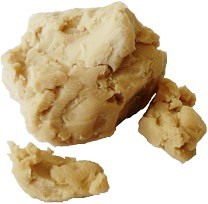 |
Fresh, live yeast -
keep it in the refrigerator. |
Yeast You should use fresh, live yeast if you can possibly get it.
You should use fresh, live yeast if you can possibly get it.
Many supermarkets buy more than they need and with experience, they will know how much they can give away.
It is in their interest to support people making their own bread because those people also buy other ingredients from the shop such as flour and so on so you should be able to get it for free.
* Tip - Store it for up to around three days in your refrigerator.
* Can't get it? - If you can't get fresh yeast then use powdered baker's yeast instead - roughly one sachet will do the job but it will take longer to get started.
 |
Bird-eye chillies -
wash, top and tail them. |
Chillies /Hara mirch - हरा मिर्च - ਹਰਾ ਮਿਰਚ

 These are Bird-Eye chillies. They are around 3-10cm long and roughly 6-10mm in diameter.
These are Bird-Eye chillies. They are around 3-10cm long and roughly 6-10mm in diameter.
If you bite into one of these (if you are not sure of your ability to withstand the heat, then just nibble the end 2-3mm of one and you won't get any of the hot bit), you will taste the fruitiness that you get with fresh chillies. These have a taste similar to green sweet peppers although obviously, with a lot of heat as well.
Green chillies are the hottest - the plant doesn't want anything eating the seeds until they are ripe - so the red ones are not as hot.
Top the chillies and then cut them into slices around 5mm long.
If you are not used to green chillies, then you should probably wear gloves to start with and definitely don't rub your eyes.
After a year or so of eating food like this, you will be up to full strength chilli and you won't mind if you do get some in your eyes occasionally.
I have seen some recipes in supermarket free magazines that suggest that the person preparing the meal should wear rubber gloves and scrape out all of the seeds - I wonder why they would bother with chillies and not just use a small amount of green pepper instead.
* Tip - It is not always convenient to buy fresh chillies leaf so buy a lot of them, then mince and freeze them.
* Can't get it? - If you can't get green chillies then use dried red chillies instead.
Alternatively, you can use some of the Mr Naga pickle below - sparingly.
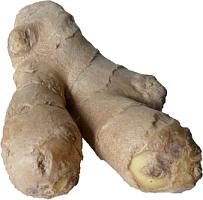 | Fresh ginger root - this is now
readily available |
|
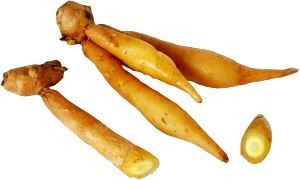 | Fresh Chinese ginger root.
This flavour is more delicate. |
|
Ginger root /Adrak - अदरक - ਅਦਰਕ /Aadi - आदि /Adu - આદુ

 This is readily available in supermarkets nowadays and you can find good quality roots just about anywhere.
This is readily available in supermarkets nowadays and you can find good quality roots just about anywhere.
Choose roots that are fresh and plump-looking and without wrinkles. They shouldn't have mould on them and any cut ends should look clean.
Chnese ginger has a more delicate flavour with more of a lemon overtone.
Store in the pantry - doesn't require refrigeration although being in the refrigerator will not make it worse.
To use it, cut off the length you want - usually an inch or so - and skin it - a potato peeler does the job nicely. Next grate it with a fine grater.
* Tip - Grate ginger root (as opposed to slicing it up) and you will be left holding a ball of fibres when you have finished. These are the bits that would end up stuck between your teeth if you left them in so get rid of them.
* Tip - Spice up a drink of Orange juice by grating a little fresh ginger root into it.
* Can't get it? - If you can't get fresh ginger then use minced ginger instead - roughly one heaped tsp for an inch of fresh.
 |
Fresh galangal root - this is fairly
readily available |
Galangal root /Galanga /Blue ginger /Thai ginger

 Galangal is not ginger - its flavour it quite different although its role in cooking in Thai curries is the same as that of ginger in other spicy meals.
Galangal is not ginger - its flavour it quite different although its role in cooking in Thai curries is the same as that of ginger in other spicy meals.
Again, select plump, fresh looking roots that have no sign of mould or wrinkles. This is usually kept in a chiller in the supermarket and the roots are sold individually in sealed bags so unless there has been a problem in transit, they should be all right - still check though.
Store it in the refrigerator to extend its life - if you are experimenting with it then you will not be consuming it as quickly as if you were using it as a normal ingredient.
* Tip - Like ginger above, grate it so that it's flavour spreads throughout the meal.
* Tip - Spice up a drink of Orange juice by grating a little fresh galangal root into it.
* Can't get it? - If you can't get fresh galangal, use ready-minced from the bottle or failing that, substitute it weight for weight with fresh ginger and add a small pinch of pepper.
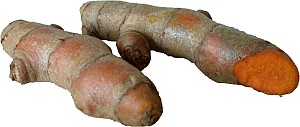 | Fresh Chinese turmeric root.
Look in Chinese supermarkets. |
|
 | Fresh Indian turmeric root - from Chinese
supermarkets and Asian supermarkets. |
|
Turmeric root /Haldi हल्दी - ਹਲਦੀ /Haldar - હળદર 
 With the only exceptions really being where you are adding turmeric to floury ingredients - onion bhaji and so on - I would recommend using fresh turmeric root.
With the only exceptions really being where you are adding turmeric to floury ingredients - onion bhaji and so on - I would recommend using fresh turmeric root.
Store it in the refrigerator - mainly because you can keep track of where it is.
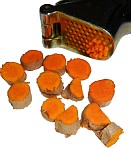 |
A sturdy garlic press
does the job nicely. |
The roots are small - around 1cm across - and can easily get mixed up with other ingredients if you don't take care of them.
* Tip - If you want to produce a lot of frozen, pre-shdredded turmeric so that you can just break off a block and put it in your food at the correct time, go for the Indian turmeric - it costs less and by normally being sold loose, you can pick and choose how much bulk you want.
Once you get it home, cot off any damaged bits and then grate it using a small (around 2mm hole size) grate. There is no need to remove the skin because that will not pass through the grater.
* Tip - If you are going to press turmeric through a garlic press, cut it into thin - 4mm or so - slices and put them in the press with the cut surface of the root facing the holes.
You will still need to use a lot of force - remember, you are not trying to juice it, you are trying to force it through a lot of small holes. If you can't get it through a garlic press, just skin it and grate it.
* Tip - This will stain your fingers - some people might even think that you have taken up smoking. Wearing thin rubber /plastic gloves might turn out to be a serious option for you.
* Can't get it? - If you can't get fresh turmeric then use powdered turmeric instead - roughly one heaped tsp for an inch of fresh.
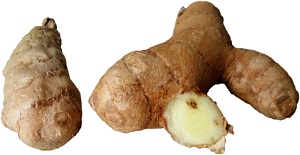 |
Fresh white turmeric root -
look in Asian supermarkets. |
White Turmeric root /Mango Ginger /Amba Haldi अम्ब हल्दी - ਅੰਬ ਹਲਦੀ Unlike the yellow turmeric above, this has a taste like fresh mangoes (although with a hint of lemon) - hence the name 'Amba haldi'.
Unlike the yellow turmeric above, this has a taste like fresh mangoes (although with a hint of lemon) - hence the name 'Amba haldi'.
This is seasonal - you can find fresh roots from late spring into summer.
Store it in the pantry. The roots are small - around 1cm across, looking more like smaller versions of normal ginger than a white version of yellow turmeric.
This is tender so you can just skin it and eat it raw or blanched.
It is normally added to pickles although there is no reason why you can't add it to other things.
* Tip - Like galangal above, you can add it to drinks - just grate a bit into some orange juice for a refreshing alternative to orange juice on its own.
* Warning - If you are pregnant, don't consume white turmeric - there are apparently links between it and miscarriages.
* Can't get it? - For adding grated to drinks, try grated mango - these don't have to be particularly ripe.
Alternatively, if a powder will do, try Ambchoor (ਅੰਬਚੂਰ) /Amchoor (आमचूर पाउडर) which is powdered dried unripe mango and can be bought in smallish packs in the spice section.
Daikon / Mooli - मुळा - ਮੂਲੀ 

 You can find this large (0.5m long) white radish in English supermarkets now.
You can find this large (0.5m long) white radish in English supermarkets now.
 |
Mooli - white radish, half a metre long.
|
To use it, skin it and grate it then squeeze the excess water out of it. Keep the water and use it in another part of the recipe.
You can use it in paratha, pakora and koftas.
* Can't get it? - If for making paratha, kofta, pakora and so on, you can't get hold of mooli then use either lauki or torai instead.
 |
Lauki, doodhi, kaddoo, ghiya and
so on. Learn the names. |
Lauki - लौकी /Doodhi - दूदी - दूधी /Kaddoo - ਕੱਦੂ /Ghiya - घीया - ਘੀਆ /Calabash

 This bottle gourd is finding its way into English supermarkets - at least where they have a population that knows what to do with it.
This bottle gourd is finding its way into English supermarkets - at least where they have a population that knows what to do with it.
The English supermarkets that stock it tend to have fairly straight ones although they can vary in length 8-12" and around 2-3" in diameter. The Asian supermarkets also have slightly different laukis, shorter, rounder, more bent and so on although the colour is fairly consistent between them all.
The interior will withstand coarse grating and it goes well in Sabji and Koftas. You will find it in Chinese supermarkets where it is used as an ingredient in soups.
* Tip - It is worth learning the different names for this vegetable - I know of four people who between, them use a different name for it whilst not knowing the other names for it - Lauki, Doodhi, Kaddoo and Ghiya. It also has different names in the shops I go to.
* Interestingly - This gourd was domesticated a very long time ago. It started off somewhere in Africa or Eurasia and around 8,000 years ago, found its way into America. Whilst being cultivated, it has changed over the years so the African and Asian varieties are different.
The varieties found in America match more closely the Asian varieties than the African varieties so the theory that the seed had somehow drifted across the Atlantic ocean loses its attractiveness when compared to the theory that humans carried it with them as they migrated through Asia to the Americas.
* Can't get it? - If for making paratha, kofta, pakora and so on, you can't get hold of lauki then use either mooli or torai instead.
 |
This is torai - possibly one of the strangest vegetables
you are likely to encounter with the intention of cooking it. |
Torai - तोरई - तुरई - तोरी /Chinese Okra /Dodke - दोडके /Shirale - शिराळे /Ridge Gourd

 Torai is immature and has large, soft white seeds. When put in a paratha, some of the seeds are roasted by the tava and adopt a typical roasted seed flavour.
Torai is immature and has large, soft white seeds. When put in a paratha, some of the seeds are roasted by the tava and adopt a typical roasted seed flavour.
Try to pick reasonable looking ones without any mould on them. The young vegetable has hard ridges along it and the surface between them is concave. It looks a bit like a green Zepplin but without the tail fins.
This vegetable is too springy to be grated - it is very bendy and does not lend itself to this process at all - so ideally, you should chop it up lengthways into eight - half, then half, then half again - and then cot those strips into small pieces, retaining any seeds that become separated.
* Interestingly - This vegetable is actually the immature and edible stage of the vegetable that, if allowed to grow on to maturity, is used to make a loofah/ luffa.
When making loofah out of this, the torai is allowed to grow to full maturity - so that the springy structure inside it is fully grown - and then the soft, edible parts are allowed to rot, leaving just the skeletal, fibrous structure.
* Can't get it? - If for making paratha, kofta, pakora and so on, you can't get hold of torai then use either mooli or lauki instead.
 |
Bhindi, okra or 'lady's fingers'.
They can be eaten raw if you like. |
Bhindi - भिण्डी - भिंडी - ਭਿੰਡੀ /Bheenda - ભીંડા /Bhendi - भेंडी /Bamiya /Okra /Lady's Fingers 
 Bhindi are immature seed pods, picked within a week of the plant flowering.
Bhindi are immature seed pods, picked within a week of the plant flowering.
One notable characteristic of them is that they have an unusual cross-section - having usually five chambers within which the seeds grow.
The younger these are, the more tender they will be - the older they get, the woodier they get and you can end up with something that resembles cooked soggy newspaper.
* Note - They are tender and can be eaten raw - with this in mind, the cooking time can, for steaming, go anywhere from nothing to a point where they start to go mushy. I usually steam them over the rest of the food for around 10 minutes.
* Tip - Buy from a shop that has a high turnover of fresh vegetables - shops that don't have a lot of people buying bhindi might well have older stock.
* Tip - Buy shorter bhindi, they should be younger and therefore more tender.
* Tip - Cook the bhindi that you have bought by the end of the day after purchase - it will start to get old after that.
* Tip - As with any other fresh vegetables, you need to wash it before you use it. Make sure that you wash bhindi before you cut into them. If you wash them afterwards, they will go spectacularly slimy.
* Tip - Unless you stir-fry them so that they only come into contact with oil, they will have water condense on them and they will start to go a little slimy. Sprinkle a little acidic liquid on them - lemon or lime juice, even vinegar - and slime production will not be as great.
* Warning - bhindi does have diuretic properties (although not always). This doesn't always happen but if access to a toilet is an issue then it is probably best to avoid this one, just to be safe.
* Can't get it? - If you can't get fresh bhindi then use frozen instead.
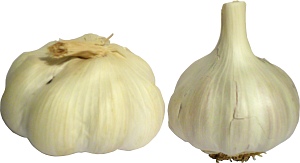 |
Garlic. Larger,
milder bulb on the left. |
Garlic / Lehsun - लहसुन /Lasan લસણ /Lasun लसुण

 This is used in cooking all over the world and is readily available as: whole garlic bulbs; dried flakes; bottled, pre-crushed garlic; frozen, pre-crushed garlic; dried garlic powder and so on.
This is used in cooking all over the world and is readily available as: whole garlic bulbs; dried flakes; bottled, pre-crushed garlic; frozen, pre-crushed garlic; dried garlic powder and so on.
It is also available as an additive to salt which can make salads and the like more interesting.
The English supermarkets tend to stock the smaller, stronger bulbs whereas the Asian shops tend to stock the larger bulbs - the larger bulbs are better.
* Tip - Store the bulbs in a cool, dry, well-ventilated place.
* Tip - Buy bulbs that are intact and without any brown patches on them.
* Can't get it? - If you can't get fresh garlic then use bottled, pre-crushed garlic instead.
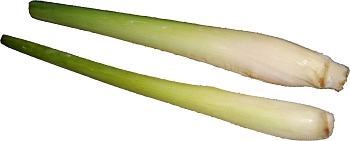 |
Lemongrass. Choose plump,
healthy-looking stems. |
Lemon Grass  Used in south-east Asian cooking, this is used with galangal to make up the flavour base for a Thai curry.
Used in south-east Asian cooking, this is used with galangal to make up the flavour base for a Thai curry.
Pick fresh-looking stems - rejecting dried out papery, faded, yellow/brown stems.
If you crush the end of one of the stems that you have bought, it should small like lemons. When used in cooking, it is usually top and tailed - only cutting off half an inch of the top and trimming off to just above the root - and then finely chopped.
* Can't get it? - If you can't get fresh lemongrass then use dried, chopped from the spice rack instead.
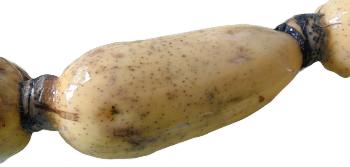 |
Fresh lotus root. This is a
root that grows underwater. |
Lotus root - कमल - ਕਮਲ - કમળ This is the root of the water lily, or lotus, that grows on the bottom of ponds.
This is the root of the water lily, or lotus, that grows on the bottom of ponds.
Consequently, it has a fairly impenetrable - and also brittle - surface although you can fairly easily remove it by using a potato peeler.
If you hold the peeler at 45 degrees to the direction you are moving it then it is more of a slicing than cutting action and works better.
The interior of the root is also fairly brittle and when cutting it you should bear this in mind by making sure that when the blade is part way through the cut, it is not at an angle that would make the part you are cutting off break.
* Can't get it? - If you can't get fresh lotus root then use dried lotus root instead, although this not so good for making chips.
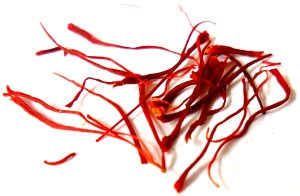 |
Saffron is expensive but it has qualities
that its substitutes don't have. |
Saffron /Kesar - ਕੇਸਰ - केसर

 Saffron is sold only in small amounts, usually in a largeish but flat container - such as the one below which is roughly 6.5cm diameter and 6mm thick, the inside consisting mainly of a piece of
Saffron is sold only in small amounts, usually in a largeish but flat container - such as the one below which is roughly 6.5cm diameter and 6mm thick, the inside consisting mainly of a piece of 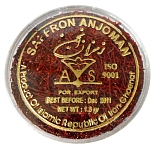 |
A small quantity like this
is expensive but it lasts. |
cardboard and has a nett weight of 1.3grammes of saffron - which is (and should be) difficult to open - you won't want it to open by accident.
You only need a very small amount of this to colour and flavour food so it is worth buying such a quantity as it will last a long time.
Make sure that the saffron you choose is well within its sell-by date.
Some recipes just suggest that you add the saffron to whatever the food is that you are preparing.
However, I have found that it is best to grind up the dry saffron first and then wash it into the food because this releases far more of the colour than just putting in whole stigmas.
Only three saffron stigmas come from each crocus flower so many are needed in order to collect any sort of quantity - around 150 flowers produces one gramme of saffron.
* Tip - This is sold in very small amounts, very expensive but you only need a tiny amount. So, keep it in a cool, dry place, well out of reach of inquisitive children. I have found that the best place is the bottom of a drawer where it cannot fall open or tip over.
* Can't get it? - If you can't get saffron then use turmeric or yellow food dye for colouring instead.
 |
Green Cardamom
|
Green Cardamom /Elaichi - ਇਲਾਇਚੀ - इलायची - ઇલાયચી /Veldoda - वेलदोडा
 Green cardamom is sold as powder and as the whole seed pods.
Green cardamom is sold as powder and as the whole seed pods.
The seed pods are better because they have not been broken open and still contain the volatile chemicals that give green cardamom its unique flavour and smell.
The flavour of cardamom is a warming, gingery/camphor taste. This lends itself to sweet dishes.
* Tip - In order to grind cardamom seeds better, once you have removed the seeds and discarded the empty pods, add a pinch of sugar to the mortar and pestle and continue grinding. You will see the difference straight away and as cardamom is almost always used in sweet recipes, a small amount of extra sugar isn't going to change the recipe.
* Tip - Instead of spending a small fortune on fancy chewing gum, just chew cardamom pods - remembering that you are only supposed to eat the seeds - disposing responsibly of the empty pod once you have finished with it.
* Interestingly - You can demonstrate to yourself that flavours and scents change according to concentration by sucking on a unbroken, whole cardamom pod.
It will taste quite gingery and that flavour will last. However, if you break open the pod in your mouth, the flavour will change to a minty/mothball sort of flavour.
Virtually all flavours of herbs and spices used in cooking (fruits excepted) are there to stop insects from eating the seeds. The cardamom produces, what is instantly recognisable when you crunch a whole seed pod and experience it in high concentration, moth repellent.
* Can't get it? - If you can't get whole cardamom pods then use the powder instead.
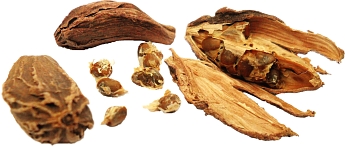 |
Black Cardamom
|
Black Cardamom /Brown Cardamom /Badi Elaichi (big cardamom) - बड़ी इलायची Black cardamom has more of the camphory, menthol flavour - making it more of a challenge to people who want something to chew.
Black cardamom has more of the camphory, menthol flavour - making it more of a challenge to people who want something to chew.
In addition, the pods have a smoky flavour and smell to them. This is more down to the way that the pods are dried than anything else - they are dried over a fire.
As a result of this, they lend themselves more to savoury dishes.
* Tip - Something to be aware of when trying to grind these in a mortar and pestle is that the pods are quite woody and you can end up with shards of wood that will not be very comfortable to eat. If you are not using a blender, you can seive the powder once you have made it.
* Can't get it? - If you can't get whole black cardamom pods then use black cardamom powder instead.
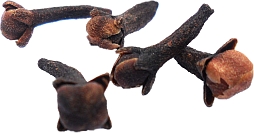 |
Cloves
|
Cloves /Laung - ਲੌਂਗ - लौंग - लौङ्ग /Lavanga - लवंग - लवङ्ग
 Cloves are one of the warming spices and are used in garam masala spice mix.
Cloves are one of the warming spices and are used in garam masala spice mix.
They are used in the sweeter end of recipes such as sweet rice.
* Can't get it? - If you can't get whole cloves then use powdered cloves instead.
 |
Coriander seeds
|
Coriander seed /Dhaniya - धनिया - ਧਨੀਆ /Kothmir ખોથમીર /Dhana ધાણા /Cilantro

 This is coriander seed. It is what is powdered to make coriander powder.
This is coriander seed. It is what is powdered to make coriander powder.
As a rule, you should fry or roast spices like this to bring out their flavour so use it at the beginning of the cooking process where high temperatures are used - you will not manage this by the time the onions go in, for example.
* Tip - When using coriander in a recipe - either seed (powdered or crushed) or carriander leaf - add some lemon or lime juice to it. This really brings out the flavour and adds substantially to the meal.
* Warning - Coriander leaf and seed are not interchangeable with each other because the flavours are completely different. You can have recipes with both included but they do different jobs.
* Can't get it? - If you can't get coriander seed and but need the flavour then use coriander powder instead. If you can't get that, you need to go to the shops.
 |
Coriander leaf
|
Coriander leaf /Hara Dhaniya - हरा धनिया - ਹਰਾ ਧਨੀਆ /Cilantro

 This is the other coriander. It has a completely different taste and smell to its seeds.
This is the other coriander. It has a completely different taste and smell to its seeds.
When cooking with it, add it towards the end of the procedure so that it's flavours are not destroyed by the heat of the earlier parts of cooking.
* Tip - When using coriander in a recipe - either seed (powdered or crushed) or carriander leaf - add some lemon or lime juice to it. This really brings out the flavour and adds substantially to the meal.
 |
Coriander needs water
and light to keep fresh. |
* Tip - Fresh coriander leaf is living and if you put it in some water and give it some light, it will stay fresh for longer than if you just put it in a cupboard or the refrigerator and let it die.
* Tip - It is not always convenient to buy fresh coriander leaf so buy a lot then mince and freeze it.
* Warning - Coriander leaf and seed are not interchangeable with each other because the flavours are completely different. You can have recipes with both included but they do different jobs.
* Can't get it? - If you can't get fresh coriander leaf then use minced or dried instead. Dried is not as good but it is still better than nothing.
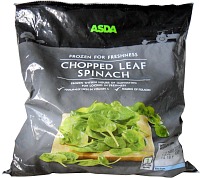 |
Spinach, cleaned, chopped
and frozen into briquettes |
Spinach /Palak - पालक - ਪਾਲਕ
 Palak is available as fresh, tinned or frozen in the UK.
Palak is available as fresh, tinned or frozen in the UK.
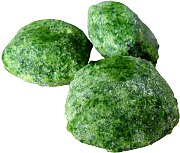 |
Palak briquettes.
What could be simpler? |
* With fresh, you either use it fairly quickly or mince it and freeze it - see cheats - ingredients to make things easier for more about doing this yourself.
* With tinned, you are commited to using the whole tin - which might be quite a bit more than you need - alright for Saag but if you are making paratha then there will be too much.
* With frozen, the spinach is washed then chopped up and then frozen into briquettes, similar in size to charcol briquettes that people use in barbeques or on their fires. With these, you can just add a few and the rest will keep.
* Can't get it? - If you can't get frozen and don't want the hassle of buying fresh, open a tin and freeze what you don't need.
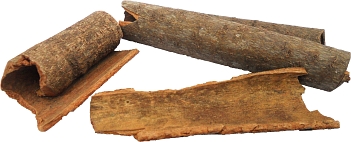 |
Cinnamon
|
Cinnamon /Dalchini - ਦਾਲਚੀਨੀ - दालचीनी /Taj - તજ
 This is another one of the warming spices.
This is another one of the warming spices.
It tends to be used in sweet recipes such as sweet rice.
Cinnamon is the inner layer of bark of a tree - which, without sounding too obvious - is why it looks just like that.
To use it, you can break off as much as you need, break it up and add to the recipe. However, one thing to be aware of is that when eating the meal, you are occasionally gong to be taking out what looks like pieces of wood. You can leave it as a few larger pieces which are easier to remove or you can use the powder instead.
* Can't get it? - If you can't get whole cinnamon bark then use powdered cinnamon instead.
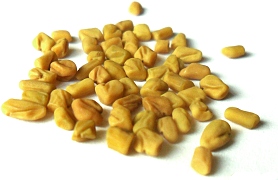 |
Methi seeds
|
Fenugreek seeds (Trigonella foenum-graecum) /Methi seeds - मेथी - ਮੇਥੀ - મેથી
 Methi gives a meal that classic 'curry' smell and flavour.
Methi gives a meal that classic 'curry' smell and flavour.
The seeds are quite hard and unless you have a grinder, are only really suitable for growing into plants where the leaves are used in cooking.
Ideally, you need the powder - which is readily available - and add that to the cooking at roughly the same time as coriander powder. See the section in the knowledge and cheats page.
* Can't get it? - If you can't get methi powder and you really need that smell, use curry leaves or, if you must, curry powder instead.
 |
Klowunji (onion) seeds
|
Klowunji (onion) seeds (Nigella Sativa) /Kalonji seeds - कलोंजी /Kalaunji - कलौंजी /Mangrail - मंगरैल - मङ्गरैल
 Onion seeds are definitely part of the savoury end of the spice spectrum.
Onion seeds are definitely part of the savoury end of the spice spectrum.
These are used mainly as an addition to naan bread and other, similar applications.
* Warning - Some recipes call klowunji seeds 'kali jeera' (black cumin) so be aware and if possible, cross check the ingredients to see if there are any clues as to its real identity.
* Can't get it? - If you can't get onion seeds (worth looking for 'nigella') then, in the case of making breads use poppy seeds instead.
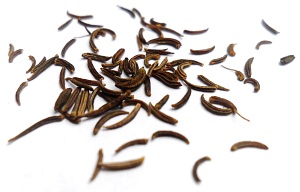 |
Kala Jeera
|
Black Cumin seeds (Bunium Persicum) /Shahi Jeera - शाही जीरा /Kala Jeera - काला जीरा - ਕਾਲਾ ਜੀਰਾ
 These are actually kala jeera seeds and as you can see, they look quite different to all of the other things that get called 'kala jeera' - onion seeds, black sesame seeds.
These are actually kala jeera seeds and as you can see, they look quite different to all of the other things that get called 'kala jeera' - onion seeds, black sesame seeds.
They have an almost smoky flavour, lending themselves to the savoury end - such as an alternative addition to potato in various fillings for samosa, paratha and so on.
* Can't get it? - If you can't get kala jeera and it is the smoky flavour you want, then try using black cardamom instead.
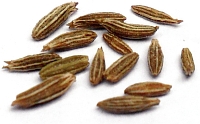 |
Jeera seeds.
These are nice when roasted. |
Jeera - ਜੀਰਾ - जीरा /Jiru - જીરૂ /Jire - जिरे /Cumin (pronounced 'क्यूमिन्' not 'कुमिन्')
 Jeera has two flavours: the raw flavour that is a little like sweaty armpits; and, a more savoury, all together nicer flavour from roasted jeera.
Jeera has two flavours: the raw flavour that is a little like sweaty armpits; and, a more savoury, all together nicer flavour from roasted jeera.
Always roast or fry jeera - usually as the first thing you do because it needs a high temperature to do it.
Adding jeera powder part way through cooking will not convert the flavour into the roast jeera flavour.
* Tip - If you forget to put the jeera in at the beginning and need to have the fried/roasted flavour of jeera, put some jeera seed in a spoon with a little oil and cook it over a naked flame. Then add that to the mixture.
* Can't get it? - If you can't get whole jeera then use powdered jeera instead.
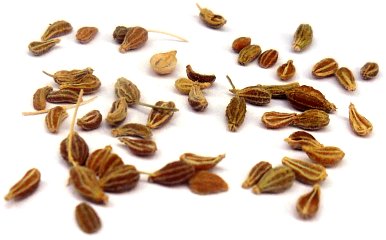 |
Anise seeds
|
Anise seeds
 Anise seeds aid digestion and most people will be familiar with them as the little seed that is at the centre of an anise seed ball.
Anise seeds aid digestion and most people will be familiar with them as the little seed that is at the centre of an anise seed ball.
These belong to the sweet end of the spectrum and are used in Khichiya papads amongst other things.
* Can't get it? - If you can't get anise seeds then use fennel seed instead.
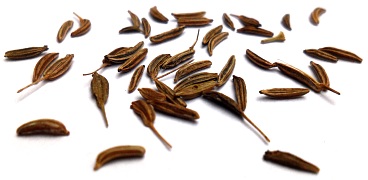 |
Caraway seeds
|
Caraway
 Caraway seeds are a digestive aid - like a lot of this family of plants' seeds, above and below.
Caraway seeds are a digestive aid - like a lot of this family of plants' seeds, above and below.
You can use caraway in the pastry of samosas instead of ajwain if you cannot get hold of ajwain.
* Can't get it? - If you can't get Caraway then use ajwain instead but remember only to use a small amount of ajwain because it can very easily take over the flavour of a meal.
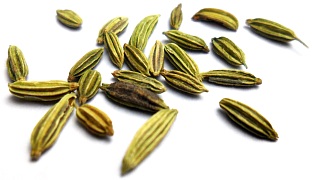 |
Fennel seeds
|
Fennel /Saunf - सौंफ - ਸੌਂਫ /Variali વરિયાળી
 Fennel is used on the sweeter end of the savoury-sweet scale and is often chewed to promote fresh breath and digestion.
Fennel is used on the sweeter end of the savoury-sweet scale and is often chewed to promote fresh breath and digestion.
You can often obtain coloured, sugar-coated fennel seeds - usually green, white and orange/red - as something to make your mouth feel clean and fresh again, after a meal.
People also reckon that it is good for your eyesight. You can make a tea from fennel and like many of the sweeter spices, there is enough flavour there to make a convincing tea.
* Can't get it? - If you can't get fennel then use anise seed instead.
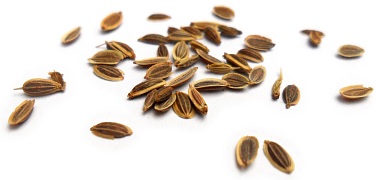 |
Dill seeds
|
Dill /Suwa - સુવા /Sawa - સવા /Sowa - सोआ /Shepu - शेपू
 This is very much like fennel above - helps with digestion. They can also be in after-dinner sweets that freshen the breath and help digestion.
This is very much like fennel above - helps with digestion. They can also be in after-dinner sweets that freshen the breath and help digestion.
It is used a lot in pickles so consider it an alternative or an addition if you are making them.
* Warning - Another name for this is Laotian Coriander or Lao Cilantro in Thailand and Vietnam respectively so if you see one of those names mentioned in a recipe, it is dill that is being talked about.
* Can't get it? - If you can't get dill then use caraway seed instead.
 |
Black and white
sesame seeds. |
Sesame /Til - तिल - ਤਿਲ - तीळ

 Sesame seeds are small and oily and come in black and white.
Sesame seeds are small and oily and come in black and white.
Black sesame and white sesame taste the same and there is a tendency for white sesame seeds to be used in the west whilst black sesame seeds are used in the east.
* Warning - Black sesame seeds, in some recipes, are incorrectly called 'kali jeera'. Sesame seeds are not kali jeera - see kali jeera above.
* Can't get it? - If you can't get black sesame seeds, then white ones will do instead.
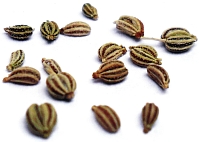 |
Ajwain seeds. They are
only around 2mm long |
Ajwain - अजवायन /Ajowan Caraway /Jawain - ਜਵੈਣ /Owa - ओवा /Ajmo - અજમો /Carom Ajwain has a flavour similar to caraway but is very much stronger.
Ajwain has a flavour similar to caraway but is very much stronger.
It is used in the pastry of samosas and it sometimes used with potato when it is used as a filling for paratha and so on.
Be careful of how much you use because it can very easily take over the flavour of a meal. It is better to be cautious about its use rather than generous.
* Can't get it? - If you can't get Ajwain then use caraway seed instead although you will need to use more of it.
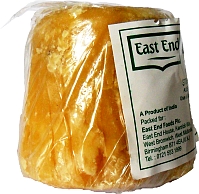 |
Jaggery - boiled-down
sugar cane. |
Jaggery /Goor - गूड़ /Shakkar - शक्कर /Gole - ગોળ /Gool - गूळ  This Indian product is made from boiling down the liquid from sugar cane.
This Indian product is made from boiling down the liquid from sugar cane.
Water is driven off by boiling until you end up with a liquid/slurry that sets solid when it gets cold.
As a result of this, Jaggery is all of the sugar cane liquid - everything that was soluble that was in the sugar cane is here and it has a light, grassy smell from the sugar cane that you rarely find in other sugars.
Jaggery is fairly soft and can easily be broken off and crushed down to a consistency similar to soft brown sugar.
Carrying all of the flavours and other chemicals that are in molasses, it has a lot of flavour of its own so if you are adding it to something, think about how it will change the flavour as well as how much sweeter it will make it.
 |
Chinese sugar - partially
crystallized and then filtered. |
Chinese sugar cane This is roughly the Chinese equivalent of Jaggery.
This is roughly the Chinese equivalent of Jaggery.
You can see that it is comprised of three layers and if you see the actual sugar itself, you will be able to see that there is a surface that has a woven appearance, suggesting a filter of some kind, and a smooth layer that has the occasional bubble on it, suggesting that it is the surface.
When you break down this sugar, you notice that it has finer sugar crystals than the jaggery and also that it is harder - suggesting that it has a slightly lower molasses/water content and and also that it is the product of filtration.
This implies that there was some solution left over that still had something dissolved in it - this water stream could be reboiled with the next batch or discarded, I don't know.
One thing is for sure and that is that this particular sugar doesn't have the light, grassy smelling ends (chemicals) in it that the jaggery does that gives it a distinct flavour and smell.
There are, however Chinese sugar products that do. Look for a product that looks as though it has been formed the same way that Jaggery has - there are some Chinese sugars you can buy that are balls of jaggery-like sugar, around 6cm in diameter.
There is a lot to choose from with some sugars being large (around 1cm or so) single crystals of sugar and so on.
* Can't get it? - If you can't get Jaggery or Chinese can sugar like this, then use normal light brown cane sugar instead although you won't get the light ends that are a distinct smell of the jaggery.
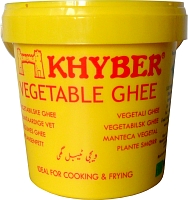 |
Gheo or Ghee. Normally clarified
butter but this is vegetable Gheo. |
Ghee - घी - ઘી /Gheo - ਘੀਉ - घ्यू /Clarified Butter /Tup - तूप
 Gheo is traditionally made by clarifying butter - heating up butter until the oil separates out from the other stuff and then pouring that off and letting it set.
Gheo is traditionally made by clarifying butter - heating up butter until the oil separates out from the other stuff and then pouring that off and letting it set.
Clarified butter has a higher smoke-point than butter that isn't clarified so it is preferred for sauteing and so on when you would want the flavour of butter and so might not use oil.
This, however, is the vegan version of it therefore it does not harm any caste and can be eaten by vegans and people who are not tolerant of milk products.
* Can't get it? - If you can't get Gheo then use normal oil instead.
 |
Kala Namak - Black salt,
complete with volcanic aroma. |
Kala Namak - काला नमक - ਕਾਲਾ ਨਮਕ /Kala Loon - ਕਾਲਾ ਲੂਣ /Black Salt /Bire nun - बिरे नुन /Sanchal - સંચળ - સઞ્ચળ - संचळ Kala Namak is basically rock salt. The thing that makes it important is the impurities that are in it.
Kala Namak is basically rock salt. The thing that makes it important is the impurities that are in it.
Apart from the colour - which is due to iron salts in it - the most noticeable group of impurities are the sulphur-containing compounds.
These are quite strong and impart the smell of eggs - hydrogen sulphide. At this level, the toxic effects of hydrogen sulphide are not a problem - the levels are only similar to those in boiled eggs so that is not a problem.
I have only ever found this in Indian shops - usually with the powdered salt, rather than with the spices so make sure that you are looking in the right place.
* Tip - The sulphurous smell is quite strong for those who aren't used to it so be careful with how much you add. There is a fine line between adding a rather esoteric smell and taste to something, and, making people think that you have just eaten a dozen eggs that have been sitting on a radiator for the last fortnight.
* Can't get it? - If you can't get Kala Namak then use normal salt instead although you won't get the sulphur element of the salt.
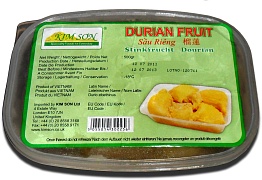 |
Durian fruit frozen.
|
Durian  The flesh of this fuit has a beautiful custard/caramel flavour. There is only one thing about it that earns it the unusual position of being banned from public transport in certain parts of south-east Asia.
The flesh of this fuit has a beautiful custard/caramel flavour. There is only one thing about it that earns it the unusual position of being banned from public transport in certain parts of south-east Asia.
In the UK, we add the vapour of a liquid to the gas supply so that you can smell when you have an escape of fuel gas into your house (it is also added to liquified petroleum gas as well such as propane, butane and mixtures of the two such as those you would take with you when camping or going on a boat). That liquid is a chemical that falls into a group of chemicals called mercaptans - they are like ethers but instead of oxygen, contain sulphur. Similar-smelling compounds are thiols and, by now you ave probably guessed that whilst durian has a beautiful flavour, it smells of mercaptans and thiols.
At the moment it is not banned from public transport in the UK and I don't suppose it will be - you can only get the fresh fruit here in summer. Still, it is fun at work, opening your little sealed container of pudding and people walking into the canteen start behaving as though they have just found a gas leak.
* Note - The smell associated with Durian flesh is no worse than the smell of cooked pizza to a vegan (just think of the small of pizza as burnt rotting vomit). If there are any food-bigots opening their mouths to complain, it might just be worth pointing that out.
* Note - Durian flesh is very high in natural sugar and as a result, it doesn't neeed any adding to it. Although you can use it in savoury dishes as well.
* Can't get it? - If you can't get fresh durian then get frozen instead.
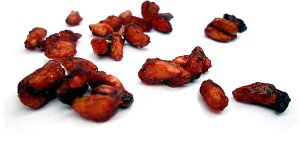 |
Anardana -
Pomegranate seeds. |
Pomegranate seeds /Anardana - ਅਨਰਦਾਨਾ - अनरदाना - અનરદાના  These are both tart and sweet.
These are both tart and sweet.
They are usually dry-roasted and then crushed up before being added to things like boiled mashed potato.
They still have with them a lot of the juicy bit that surrounds fresh pomegranate seeds but it has just been dried out.
* Can't get it? - If you can't get Anardana then for the role of tart and sweet, you might want to use pomegranate molasses instead.
 |
Pomegranate
molasses. |
Pomegranate Molasses  This liquid is both tart and sweet.
This liquid is both tart and sweet.
It is a fairly thick liquid, made by taking the juice of tart, yellow pomegranates and boiling it down until almost all of the water has gone.
The flavour is the same as the anardana above (without the seeds) but you can replace all of the hassle of grinding them up, just with a small spoonful of this.
* Note - no sugar is added to this product, pomegranate molasses is only pomegrantes, nothing else.
* Tip - In small quantities, this is also a 'secret ingredient' to add to sweet dishes such as those with apples (apple chutney or apple crumble), or savory dishes such as those with potatoes (Samosas for example).
* Can't get it? - If you can't get pomegranate molasses then for the role of tart and sweet in solid food, you might want to use dried, candied lemon peel instead.
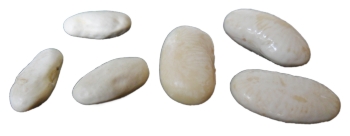 |
White kidney beans -
left:- dried; and right:- soaked. |
White Kidney Beans /Rajma राजमा White kidney beans need to be washed several times and then soaked overnight. They then need to be boiled to cook them which usually takes around 1 hour or so.
White kidney beans need to be washed several times and then soaked overnight. They then need to be boiled to cook them which usually takes around 1 hour or so.
During soaking, they swell to 2 to 3 times their original weight so make sure that you have plenty of water covering them when you leave them.
At this point, you might well be thinking about just buying some canellini beans instead but you can speed up the cooking process by making use of a pressure cooker.
* Warning - Boil at 100C for at least 10 minutes.
Kidney beans contain a chemical that needs to be broken down - this being done by heat treatment. You need to boil them at 100 Celsius for at least ten minutes.
Whilst this is only a tiny fraction of the amount of time it takes to cook them, if you are using a slow cooker, it will never get to 100C (usually getting only to around 80C) so the chemical will never be destroyed.
* Can't get it? - If you can't get white kidney beans, then use tinned canellini beans instead.
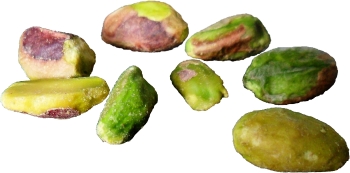 |
Pistachio nuts. They are not hard
and brittle but soft and rubbery. |
Pistachio nuts /Pista - पिस्ता - ਪਿਸਤਾ
 Pistachio nuts really are green and purple.
Pistachio nuts really are green and purple.
They are not particularly crunchy though and tend to absorb any impact elastically rather than break if you try to break them up in a mortar and pestle.
You can buy them still in the shells but if you weigh the nuts before and your yield afterwards, the price is usually about the same so, unless you have to, don't go for the ones still in their shells.
Pistachio nuts are nice roasted and will make nice flavouring in biscuits (where they will be naturally roasted in the baking process) and ice cream.
* Can't get it? - If you can't get them like this then get the ones in shell and prepare for a night in.
 |
Green sultanas and Golden sultanas.
1 |
Green sultanas and Golden sultanas Sultanas are just dried grapes and white grapes produce green and amber coloured sultanas by the time they have been dried.
Sultanas are just dried grapes and white grapes produce green and amber coloured sultanas by the time they have been dried.
Green sultanas just melt in your mouth. Regarding their texture they have no discernible skin and it is an entirely pleasurable experience (unless you suffer from cramp and these will get you so beware.)
The golden sultanas are sultanas than have treated with sulphur dioxide which has bleached a lot of the colour out of them, leaving just the golden colour behind. They do go well visually with the green sultanas but regarding texture, they do have quite a firm skin.
* Can't get it? - If you can't get them like this then regular sultanas will normally do.
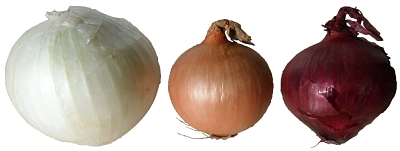 |
Onions - three types -
Brown and red are readily available. |
Onions - white brown and red. /Piaaj - ਪਿਆਜ਼ - प्याज /Dungli - દુંગળી /Kanda - કાંદા - कांदा

 Onions come in a variety of colours and whilst we are familiar with the pale greeny coloured flesh of the brown onion in the west, the white onion's flesh is very white - it still has a slight green hint to it - and the red onion is coloured with the purple dye that occurs naturally in the plant.
Onions come in a variety of colours and whilst we are familiar with the pale greeny coloured flesh of the brown onion in the west, the white onion's flesh is very white - it still has a slight green hint to it - and the red onion is coloured with the purple dye that occurs naturally in the plant.
Whist the brown onion is stronger than the others, you can, largely, use whichever you have at hand - compensating for strength by using a different amount.
The only time that it is important is if you have them playing a visual role in the meal such as in onion bhaji or couscous.
* Can't get it? - If you can't get one particular type of onion then use one of the others instead.
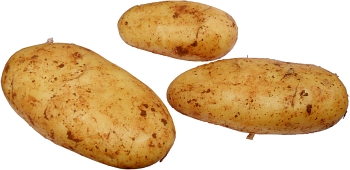 |
Cyprus Potatoes - from
the Asian supermarket. |
Cyprus - Potatoes /Aloo - ਆਲੂ - आलू /Batata - બટાટા /Bataka - બટાકા 
 Cyprus potatoes are good-quality, waxy potatoes that are good for boiling to make potato fillings - paratha, samosa and so on.
Cyprus potatoes are good-quality, waxy potatoes that are good for boiling to make potato fillings - paratha, samosa and so on.
* Tip - Instead of peeling them and then boiing them, just wash of the red clay soil (that is what they are grown in in Cyprus), remove any bits you don't want and then boil them whole. At the end, just break them open and remove the skins. That way, you don't end up with soggy mashed potato.
* Can't get it? - If you can't get Cyprus potatoes then use pretty much any other variety instead.
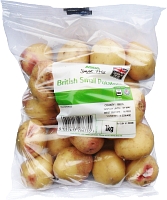 |
Small potatoes are readily
available from the local supermarket. |
Small Potatoes These are undersized potatoes, usually sold by supermarkets as their low-budget brand potatoes. They are still potatoes.
These are undersized potatoes, usually sold by supermarkets as their low-budget brand potatoes. They are still potatoes.
Just remove any bits you don't want, wash them and boil them. They are good for samosas and so on and ideal for aloo saag.
* Can't get it? - If you can't get small potatoes then use new potatoes instead - if size is not an issue then normal, large potatoes will do.
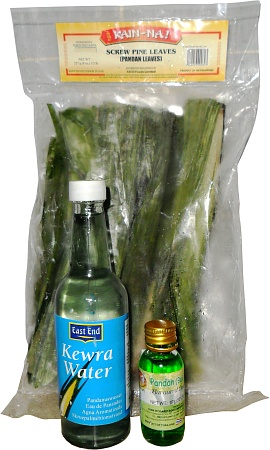 |
Pandan, frozen, essence and water.
|
Pandan / Screw Pine / Kewra केवड़ा - ਕੇਵੜਾ - કેવડ઼ા

 Screw-pine has many varieties and a number of products are available in the UK that are made from various part of the plant.
Screw-pine has many varieties and a number of products are available in the UK that are made from various part of the plant.
These are the products that I have managed to track down so far...
Frozen Leaves called 'Screw pine' leaves - they are from Thailand and English is the predominant language when it comes to food labelling for export to the UK.
called 'Screw pine' leaves - they are from Thailand and English is the predominant language when it comes to food labelling for export to the UK.
The leaves are around 4cm wide and 0.5m long - folded up, stuffed into a bag and frozen - use one per serving if using for flavouring.
Just take one or two out, let it thaw for a couple of minutes and it is ready to use - boiling with rice or wrapping food up in.
You can also grind these down to make a "paste" (take the leaves, add a little water and blend - seive out the fibre to leave a liquid - called "paste") which can be used in sweet foods such as cakes and so on.
Essence called 'Pandan'. It is made from an extract of the leaves and can be used in all of those places where leaves just get in the way - such as in ice cream, cakes and so on.
called 'Pandan'. It is made from an extract of the leaves and can be used in all of those places where leaves just get in the way - such as in ice cream, cakes and so on.
This smells the same as the Screw pin leaves as you might expect - use ½tsp per serving.
Water called 'Kewra Water' [sometimes 'kewda'] (If you want to pronounce it in the shop so that people might understand what you are saying, first, forget 'ew' sounding like 'ee-oo'. The 'e' of 'kewra' is pronounced like the 'ae' in 'aeroplane', the 'w' has its normal role as in the 'w' of 'Wednesday' and the 'r'/'d' is a retroflex consonant that sounds like a cross between a 'r' and a 'd', so push that tongue back.)
called 'Kewra Water' [sometimes 'kewda'] (If you want to pronounce it in the shop so that people might understand what you are saying, first, forget 'ew' sounding like 'ee-oo'. The 'e' of 'kewra' is pronounced like the 'ae' in 'aeroplane', the 'w' has its normal role as in the 'w' of 'Wednesday' and the 'r'/'d' is a retroflex consonant that sounds like a cross between a 'r' and a 'd', so push that tongue back.)
It is slightly different to the leaf products in that it is an extract made from the scew pine flowers.
As you might expect, there are other volatile compounts in there that give it a slightly different, more delicate flavour.
This is more suited to cakes and ice cream than the leaf products above.
Pandan Paste made from pulverising the leaves.
made from pulverising the leaves.
More liquid than what we would think of as a paste, this is difficult to get hold of so you can make your own from Pandan leaves by following these instructions.
* Can't get it? - If you can't get any one of these, then you can substitute it with any of the others - the difference between the leaf and flower products is little compared to the overall value of the flavouring/scent.
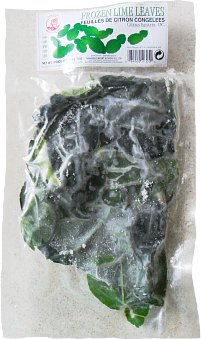 |
Frozen Kaffir lime leaves
|
Frozen Kaffir Lime Leaves These are the leaves of the kaffir lime tree - the fruit of which are a small warty lime.
These are the leaves of the kaffir lime tree - the fruit of which are a small warty lime.
The leaves are an interesting 'double' leaf on a single stem and the frozen leaves have a smell and taste very strongly of a crisp, clean lime.
You need only the equivalent of one leaf per meal to be more than enough - try it out for taste.
Being frozen, the flavour and scent oils are locked in and fresh when you buy it. Also, by being frozen, the cells have already been damaged by ice crystal growth during the freezing process and therefore release their flavour more readily.
* Can't get it? - If you can't get frozen kaffir lime leaves then use dried leaves from the spice rack instead although the quality of the flavour is vastly inferior to the frozen leaves.
You might find that in addition (or even instead of) dried lime leaves, you would be better off using bottled lime juice for convenience or, if you can get hold of fresh lime fruits, some of the zest of a lime.
 |
Fresh tofu - not to be confused with
the 'silken tofu' you get in cartons. |
Tofu

 This is cheese made from soya milk.
This is cheese made from soya milk.
Unlike the cheese you end up with when you curdle cow's milk, this will not melt into a ball of fat.
You can get firm tofu - like this - and it cooks well - it is rigid enough to be useful. However, you can also get silken tofu in cartons and that isn't very useful at all.
Tofu is available fresh, like this, or in packets of smoked or marinated or in tins from the Chinese supermarket - usually flavoured with red bean or something.
* Tip - For fresh tofu, chop the tofu up into small - roughly 1.5cm - cubes and then deep-fry it. By doing that, the surface becomes dehydrated and, in addition to having a cooked tofu flavour, it will also take on the flavour of whatever sauce you are putting it in, whether it is a curry sauce or hoi sin sauce.
* Can't get it? - If you can't get fresh tofu then use packet smoked from the supermarket instead.
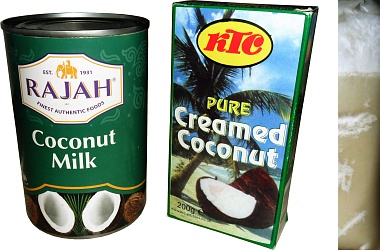 |
Coconut milk and creamed coconut -
inset: solid creamed coconut. |
Coconut Milk and Creamed Coconut / Nariyal - नारियल /Nariwal - नारिवल /Narikair - नारिकेर /Naral - नारळ /Shrifal - શ્રીફળ 


 This is made from the pulp of fresh coconuts, ground up and made into a solid block - right.
This is made from the pulp of fresh coconuts, ground up and made into a solid block - right.
On the far-right, you can see the plastic bag that is inside the creamed coconut cardboard box. It has a layer of the pulp and on top of that is a smooth, solidified oil - the oil from the coconut.
This is then dispersed in water to make the coconut milk that is in the tin on the left.
The Coconut milk is just the fat in water and is quite an opaque white. It has very little resemblence to the sweet liquid that is inside fresh coconuts when you break them open.
The liquid from the inside of freshly opened coconuts - what people would call coconut milk - is not as opaque and is quite sweet and called by some 'coconut water'. The tinned stuff is more like finely divided fat in water.
If you put a surface such as clean plastic or metal into the commercial cocomut milk, it will coat that surface in fat.
* Tip - If you add too much chilli to a meal, just add between a half and one cubic inch of creamed coconut and it will cool it down.
* Can't get it? - If you can't get coconut milk then blend some creamed coconut with some water.
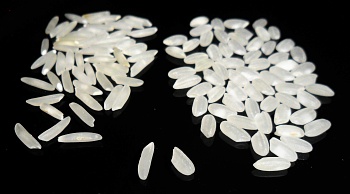 |
Long- and short-grain rice.
|
Rice / Chawal - चावल / Jhona - ਝੋਨਾ / Tandool - तांदूळ - तान्दूळ 

 There are a number of different types of rice that you can buy - in fact, it might seem that you are spoilt for choice.
There are a number of different types of rice that you can buy - in fact, it might seem that you are spoilt for choice.
There are:
- various lengths of the grain, compared to the width - you can see what long and short grained rice looks like in the photograph. Keeping it simple, use short (pudding rice) for sushi and long (try Basamati) for pretty much everything else;
- different amounts of the outside removed - you can get brown rice (healthiest), white rice (still has the bran residue and looks a creamy colour) and polished rice (is just the starch bit). white or polished will do for most;
- levels of pre-cooking - you can get uncooked or partially cooked rice - the latter only taking around 10 minutes to cook. Choose whatever is most convenient
Keep in stock some rice because it is very versatile and many meals use it.
* Tip - Use a little saffron to colour it yellow and impart a nice flavour on it
* Can't get it? - If you can't get the type you want then, unless it has a specific purpose, such as for sushi, any rice will do.
Buckwheat

 |
Buckwheat:- 1. Raw;
2. Roasted; then, 3. Boiled. |
This is Buckwheat seed.
It is a small seed, around 3mm across, which as a thin outer shell and amost all the rest of it is flour.
You will almost always find it in proper healthfood shops in both its raw and roast stages. In supermarkets, you will occasionally find it where it will stay for its shelf-life and then it will be withdrawn for maybe another six months or so, because nobody (or very few people) bought it. Why? Because the general population in the UK doesn't know what to do with it.
Generally, you need to roast it - I think it is better to have the raw and roast it yourself, rather than buy the ready-roast - then boil it with 2½ times its volume of water and then treat it as you would minced meat or substitute. It doesn't taste the same as minced meat but it isn't trying to - it just has a similar role in your food.
* Can't get it? - If you can't get raw buckwheat then use the ready-roasted instead.
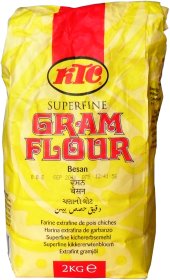 |
This is finely ground
chick pea flour. |
Chick Pea flour / Gram flour / Wesan - ਵੇਸਨ / Besan - ਬੇਸਨ - बेसन - બેસન / Chanano lot - ચણાનો લોટ 
 This is finely ground chick pea flour.
This is finely ground chick pea flour.
It forms a dough only by capillary attraction - it relies upon the fact that you are using heat to hydrolyse the starch in it, to hold it together.
Despite that, it does hold together quite well and you will see this flour in onion bhajis, pakoras, kofta and even in some of the sweets.
It has got quite a 'beany' taste which needs cooking out of it so if you are using it in sweets, you need to make certain that it is well cooked.
* Can't get it? - If you can't get besan then for meals where it is the main ingredient, you need to choose something else to make. However, where its use is not particularly important, such as in jalebi or boondi, use strong some other flour instead - rice, wheat, buckwheat and so on.
 |
This is whole wheat flour that has been
stone-ground until it is extremely fine. |
Chapatti flour / Chakki Atta - चक्की आटा - ਚੱਕੀ ਆਟਾ
 This is exceptionally finely stone-milled, wholewheat flour.
This is exceptionally finely stone-milled, wholewheat flour.
It hasn't got a particularly high protein content - the Indian climate isn't as cold as Canada's - but it does make very good chapatties/roti.
Real roti is made only with flour and water - no salt, no oil - so, armed with a tava and a small mixing bowl, you can very quickly make fresh roti.
After making small quantities a few times, you become familiar with the quantities of flour and water involved and can make really good roti, very quickly.
* Can't get it? - If you can't get Chakki Atta then use strong plain wholewheat (breadmaking) flour instead.
 |
This is ground-up maize and
comes in coarse and fine. |
Cornmeal - Fine

 This is the kernels of maize, ground up into a powder.
This is the kernels of maize, ground up into a powder.
It is not to be confused with the 'nixtamalized' maize flour, known as 'masa harina' which is used to make tortillas as one of just two ingredients - the other being water.
Cornmeal will not form a dough - mixing it with water just priduces a slurry, similar to sand and water.
* Can't get it? - If you can't get fine cornmeal, then coarse cornmeal will do instead.
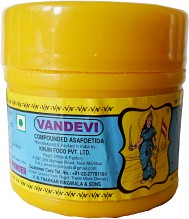 |
This powdered plant sap is so
strong that it is cut with rice flour. |
Asafoetida / Hing - हीङ्ग हींग - હિંગ
 Asafoetida is the condensed sap of a plant. It has the wonderful properties of smelling like garlic and reducing the 'fragrance' of flatulence.
Asafoetida is the condensed sap of a plant. It has the wonderful properties of smelling like garlic and reducing the 'fragrance' of flatulence.
It is very strong so only small quantities are needed. With this in mind, it is cut with rice flour and there is some turmeric powder in it so that you can visualise how much you have added.
You need to put this in at the beginning of cooking, when you are frying your jeera. The asafoetida needs to dissolve in oil and it can only do this at high temperatures
* Can't get it? - If you can't get hing like this then use asafoetida from the supermarket instead. It is worth keeping an eye out for this until you have a supply worked out. Once you have bought some, it will last a while so a small pot like this one should last several months (two ounces).
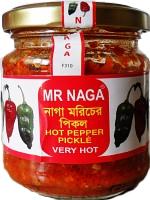 |
Reinforce chilli with this -
flavoursome as well as hot. |
Mr Naga Chilli Pickle. The Dorset Naga is the hottest chilli in the world. This pickle is made from Naga chillies. Need I say more?
The Dorset Naga is the hottest chilli in the world. This pickle is made from Naga chillies. Need I say more?
Remember that this is a pickle so it does tend to separate out. Just give it a good stir with a knife (easier to clean than a fork).
* Tip - If you want to add a little extra heat to a dish, add a quarter of a teaspoon of this.
* Tip - This is extremely hot so only try small quantities until you are used to it - and then, not too much at a time.
* Tip - If you add too much chilli to a meal, the way of reducing it is to add something oily such as coconut. The chemical the produces the heat prefers to dissolve in oil and by dissolving it in a higher melting point oil - such as coconut - it is less likely to escape into the water in your mouth.
* Interestingly - sugar is not the antidote to too much chilli.
* Can't get it? - If you can't get Mr Naga pickle then use one of the Mexican/American sauces instead. They don't have the same flavour as the Naga chilli - producing a dry heat instead - but they are fairly hot (instead of a quarter of a spoon, add a whole one or two to make up for the lack of strength).
 |
The pure oil from
roasted sesame seeds. |
Dark sesame oil This is the oil extracted from roast sesame seed. It is not for frying with, it is for flavour.
This is the oil extracted from roast sesame seed. It is not for frying with, it is for flavour.
Get a bottle like the one on the right - one that is pure roast sesame oil and not one that is roast sesame oil diluted in some other oil - and whilst it is expensive, it will last you.
* Tip - Use a squirt of this with some light soy sauce to make a classic Chinese flavour combination in any stir-fry
* Can't get it? - If you can't get pure roast sesame oil then use oner of the diluted varieties instead, but only get a small amount that will last until you source a proper supply of the real thing.
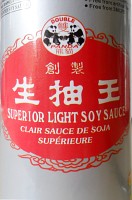 |
A nice, clean fragrant
taste and smell. |
Light soy sauce Notice that English supermarkets are not included as a source of this.
Notice that English supermarkets are not included as a source of this.
Whilst there are a number of flavour variants of soy sauce, there are essentially two types:
- Light soy sauce - Shoyu
- Dark soy sauce - Tamari
Light soy has a lot of aromatic quality and works well with roast sesame seed oil whereas dark soy sauce adds intense savoury flavour to rice and so on.
The light and dark soy sauces only have a few ingredients in them - soya beans, salt, water and wheat flour - dark soya also having sugar in the form (usually) of molasses. The stuff - for want of a better word - that you get in the supermarkets is an appalling chemical mess that if using colour as an analogy would be dark grey when compared to real soy sauces' vivid purples and oranges.
* Note - The fewer ingredients, the more that the quality of the ingredients that they do use will show through.
* Tip - Use a squirt of this with some light soy sauce to make a classic Chinese flavour combination in any stir-fry
* Can't get it? - If you can't get real soy sauce then use a small bottle of the stuff from the supermarket but don't waste a great deal of your money on anything that has more than five ingredients.
 |
The paste end of the soy sauce
process. Asian marmite. Enjoy. |
Miso
 The soy sauce process ferments wheat and soya beans with a fungus. This produces the liquid soy sauce but also a residue of fermented soya beans.
The soy sauce process ferments wheat and soya beans with a fungus. This produces the liquid soy sauce but also a residue of fermented soya beans.
Again, there are essentially two types:
- Mugi miso (barley) which is lighter and softer and, like light soy sauce is fragrant; and,
- Genmai miso (rice) which is darker and like dark soy sauce, is more about being savoury. This one is more like marmite.
* Note - The fewer ingredients, the more that the quality of the ingredients that they do use will show through.
* Tip - Stuck for something to put on your toast - try spreading a thin layer of miso on it. Treat it like marmite.
* Can't get it? - If you can't get miso for cooking with and you need it for its savoury qualities then use vegetable stock cubes instead.
Hoisin sauce This is Chinese barbecue sauce.
This is Chinese barbecue sauce.
You can add it to the ingredients for making sauces (such as spring onions and os on) as you fry them or you can coat things (such as burgers and so on) as you cook them.
* Tip - Real Chinese Hoisin sauce is not at all like the western mixtures that are advertised as hoisin sauce. The real thing is far better and has a cleaner taste. There are a number of red-bean sauces - some are tinned some in jars - these are made in China. Try to get the ones made in China. You should be looking at a list of ingredients along the lines of:
| |
| Lee Kum Kee brand | Amoy |
 | Only buy real
Chinese Hoisin sauce. |
|
| Tin | Bottle |
| sugar | sugar |
| fermented salted soya bean | soya bean paste |
| rice vinegar | water |
| water | salted plum (5%) |
| garlic | salt |
| red rice koji | sesame seed paste (3.5%) |
| salt | soy sauce |
| spices | red fermented bean curd |
| caramel | red rice |
| sesame oil | corn starch (makes it thicker) |
| chilli | salted chilli pepper (1%) |
| | sesame oil |
| garlic |
| spices |
| caramel |
| acetic acid |
| |
*Note that Caramel is there as a colour and you get this in your own food when you fry onions for example; and,
Acetic acid is the acid in vinegar.
You can see that it has a fair amount of salt in it (between 3.5 and 5% that is added in the Lee Kum Kee brand sauce) and that it is made from various preparations such as soya bean paste, red fermented bean curd and so on.
* Tip - They are both fairly similar but when thinking about using the tinned variety, consider getting hold of a suitable jar to store it in as well.
* Can't get it? - If you can't get Hoisin sauce then use any barbecue sauce instead. It won't be as good but it will probably do once in a while.
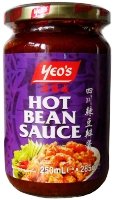 |
Chinese hot bean sauce
- quick and easy. |
Hot Bean sauce This is another preparation that speeds things up a great deal.
This is another preparation that speeds things up a great deal.
It is essentially salted soya beans, chilli, garlic black bean and sesame oil.
You can make the sauce basis for a meal quickly just by fring whatever it is you are cooking, adding hot bean sauce and a little light soy sauce, fry for a couple of minutes and add some dark sesame oil - to complete it, just add noodles.
* Note - The fewer ingredients, the more that the quality of the ingredients that they do use will show through.
* Can't get it? - If you can't get Hot bean sauce then use some miso, chilli, garlic and some dark sesame oil instead.
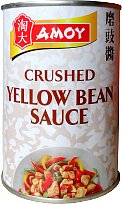 |
Chinese yellow bean
sauce - quick and easy. |
Yellow Bean sauce Yellow bean sauce is used in a similar way to hot bean sauce only it has a completely different flavour set.
Yellow bean sauce is used in a similar way to hot bean sauce only it has a completely different flavour set.
Add it to stir-fried vegetables once the frying part of the cooking process has been completed.
Meals with this go well on a bed of rice with a little dark soy sauce.
You might be tempted to buy something advertised as 'yellow bean sauce' that isn't from China but don't if you don't have to. There are only a few ingredients in this, giving it a clean taste: fermented soya beans, soy sauce, sugar water caramel (colouring).
* Tip - This is tinned so you should consider making sure that you have a jar at hand for what you don't use.
* Note - The fewer ingredients, the more that the quality of the ingredients that they do use will show through.
* Can't get it? - If you can't get yellow bean sauce then try using some hot bean sauce instead - it will be different but the sauce role will be filled.
 |
You can make your
own quite easily. |
Sushi Seasoning This is added to the short-grained rice when making sushi to give the rice some flavour of its own, make the rice more acidic, changing its physical properties and to bring out the flavour of whatever it is in the sushi that you are using.
This is added to the short-grained rice when making sushi to give the rice some flavour of its own, make the rice more acidic, changing its physical properties and to bring out the flavour of whatever it is in the sushi that you are using.
The latter part is done by using monosodium glutamate although it should be noted that although this is a natural chemical that occurs in wheat (the sodium salt of glutamic acid), eating too much has an adverse effect on you.
* Can't get it? - If you can't get sushi seasoning then try this instead.
- 25mls rice vinegar (or, failing that, spirit vinegar or even normal brown malt vinegar),
- 25mls water
- 1tsp of sugar dissolved in it
- add a pinch of Mono Sodium Glutamate if you have it (you can buy it in Indian and Chinese supermarkets), otherwise a pinch of salt instead
This is enough for one instance of the recipe Vegan Sushi - enough for around five rolls of nori (15 to 20 pieces).
You might want to make up a couple of hundred mls or so of this mixture for further use.
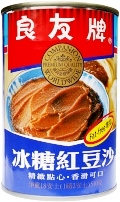 |
Red bean paste - a
centre for sweet snacks. |
Red Bean Paste Red bean paste is made from adzuki beans, boiled with sugar and then mashed.
Red bean paste is made from adzuki beans, boiled with sugar and then mashed.
It is used for making sweets and, as you can see, comes in a tin - with the usual 'once the tin is opened' issue.
Any unused red bean paste can be frozen - do this by putting it into a large, zip-seal bag, flattening it out so that it is fairly uniform and thin and then put it in the freezer. To use, just break off as much as you need and put the rest back in the freezer.
* Can't get it? - This one is fairly unique but if you can't get red bean paste for confectionery, then use jam or some other, similar, sweet viscous substance instead.
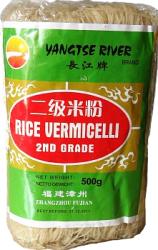 |
Rice noodles are the closest
you will get to instant noodles. |
Rice noodles Rice noodles are made by forcing cooked rice through small holes and then drying the resulting noodles out on a conveyor belt. There is no real practical way of making these yourself.
Rice noodles are made by forcing cooked rice through small holes and then drying the resulting noodles out on a conveyor belt. There is no real practical way of making these yourself.
One thing you will notice about these is the speed with which they cook. You are literally talking about one minute cooking time.
They are only slightly flavoured and will go with just about any meal - also, you can add any sauce to them and it will work.
* Can't get it? - If you can't get rice noodles then use the thinest wheat noodles that you can find instead.
 |
Commercial Cantonese
noodles are vegan. |
Cantonese noodles These are thin noodles and have only a few ingredients. You can't get them from supermarkets because they only stock varieties that have egg in them.
These are thin noodles and have only a few ingredients. You can't get them from supermarkets because they only stock varieties that have egg in them.
Being thin, they only take a few minutes to cook although you should remember that they still take a long time compared to the rice noodles above.
The colouring in them is in fact turmeric and not egg. They are vegan.
* Tip - These large packs - 1.5kg - come with 12 small portions in separate plastic bags and a resealable top. They are idea if you are going to be using a lot of them.
* Can't get it? - If you can't get Cantonese noodles then use some other thin noodles - possibly even buckwheat noodles - instead.
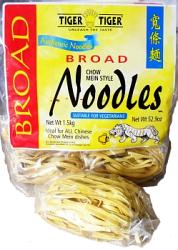 |
Commercial Chow Mein
noodles are also vegan. |
Chow mein noodles These are commercial - Chinese restaurant use - noodles bought from the Chinese supermarket.
These are commercial - Chinese restaurant use - noodles bought from the Chinese supermarket.
You can't get them from supermarkets because they only stock varieties that have egg in them.
These take a long time to cook when compared with the other noodles above - 10-20 minutes.
* Tip - These large packs - 1.5kg - come with 12 small portions in separate plastic bags and a resealable top. They are idea if you are going to be using a lot of them.
* Can't get it? - If you can't get Chow Mein noodles then use some other broad noodles or spaghetti instead - the colour isn't really an issue here.
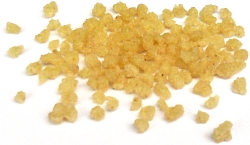 |
Couscous - the Durham
Wheat version of rice. |
Couscous Asia has rice and the Mediterranean has pasta - this is the pasta equivalent of rice.
Asia has rice and the Mediterranean has pasta - this is the pasta equivalent of rice.
However, it takes only a few minutes to absorb enugh water to have cooked and can make meals quite quickly.
Usually, peppers, onions garlic and so on go with couscous. It doesn't really work well with a large volume of tomato sauce.
* Can't get it? - If you can't get couscous then use rice noodles instead if appropriate.
 |
Soba - Japanese
Buckwheat noodles. |
Buckwheat Noodles /Soba These are what you get when you use buckwheat flour instead of durhum flour to make spaghetti.
These are what you get when you use buckwheat flour instead of durhum flour to make spaghetti.
These are individually wrapped portions, held by a small, paper tie around the middle.
Just take a portion, remove the tie and put it in boiling water, literally for a few minutes - it is that fast.
* Can't get it? - If you can't get buckwheat noodles then use rice noodles instead if appropriate.
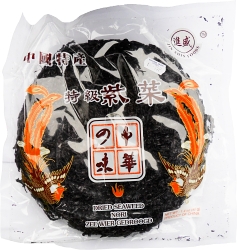 |
Nori - the seaweed that the
Welsh use to make Lava Bread. |
Nori /Lava
 This seaweed and has a lovely sea weed flavour and smell.
This seaweed and has a lovely sea weed flavour and smell.
It cooks in boiling water just as quickly as rice noodles and can be cooked along side them.
As you would expect, they have a sort of salty taste and go well with savoury meals.
Use with rice noodles to add some colour and flavour to the noodles.
* Can't get it? - If you can't get Lava like this then use sushi nori instead.
 |
Sushi Nori - seaweed sheets produced
in the same way as paper. |
Sushi Nori /Yaki Sushi Nori
 If you look at sushi nori, you will see ribs on it that make it look like an edible equivalent of laid paper - this is because it is manufactured in the same way.
If you look at sushi nori, you will see ribs on it that make it look like an edible equivalent of laid paper - this is because it is manufactured in the same way.
Sushi nori is brittle and strong but tears easily so it needs to be cut with a very sharp knife with a clean cutting edge.
Store sushi nori in a cool, dry place where it can be flat - it doesn't have to be horizontal, vertical will do, just as long as it is against a flat surface of some sort.
* Tip - Buy a sharp knife, suitable for cutting nori (around 6" blade, straight or slightly curved but not serrated) and only ever use it for this - keep the blade in plastic sheath that it was sold in and keep it in a drawer where things that are only occasionally used are stored.
The nori will take years to blunt it and by not using it for anything else, you won't end up with any irregularities on the cutting edge that will catch the nori and tear it.
* Tip - Use a stone to sharpen the knife - a ring sharpener will not produce a regular enough edge and you will tear the nori.
* Can't get it? - If you can't get Sushi nori then find a different meal to cook instead.
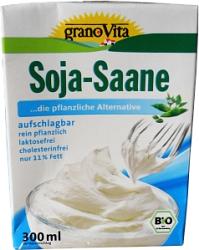 |
Soya cream - thick substitute
cream designed for whipping. |
Vegan cream This is vegan whipping cream - I have no idea how much it tastes like cream though because I am vegan and have never tasted the 'real' thing.
This is vegan whipping cream - I have no idea how much it tastes like cream though because I am vegan and have never tasted the 'real' thing.
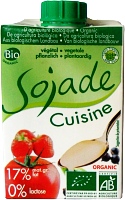 |
Soya cream - substitute
double cream. |
However, it does a particularly good job of making Gulab Jamun just right and people who have tasted them say that it is all right - they should know.
These creams are sold in little tetra-briks - 300mls for the one on the right and 200mls for the one on the left - in vegan shops and other health-food shops all over the place.
The one on the left is not particularly efficient because you can't get it all out and I get the impression that it is there as a 'treat' for people who miss cream, rather than a useful-quantity raw ingredient for cooking, like the one on the right - you can flatten the Granovita container completely.
* Can't get it? - If you can't get vegan cream then use dried soya milk powder instead.
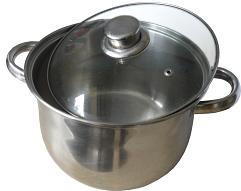 |
Budget 10 inch, thick-
-bottomed pot with lid. |
Cooking pots

 A nice deep pot with a lid is very useful and two are twice as useful - get two and only use them for your cooking.
A nice deep pot with a lid is very useful and two are twice as useful - get two and only use them for your cooking.
With two, you can process the starch (rice, potatoes and so on) and at the same time, you can do all of your frying in the other.
These pots are ideally sized for three or so day's worth of food and are deep enough so that you don't get jeera seeds jumping over the sides when you cook them.
Also, the surface area to mass ratio is such that when you have got rice to the boil with the lid on - or anything that will take a long time boiling - you can turn the heat right down and it will maintain a boil.
I use these (9" - 22cm diameter by 6" - 15cm tall) for boiling rice/beans and frying/making sauces.
You should also consider getting a small pan - called a milk pan in the UK although you don't have to boil milk in it - and the other is an 8" (20cm) diameter, 4" (10cm) deep pan with a lid.
* Can't get it? - If you can't get your own dedicated deep pans like these with lids then use something of similar size instead.
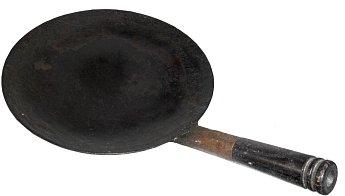 |
Tava - a small, slightly curved
griddle for making roti. |
Tava/ Tawa - तवा - ਤਵਾ Despite being fairly specialised, these are not very expensive at all - 2011 prices are around 5GBP in the Indian supermarkets although you bet that the shops that sell them as specialist items will charge at least twice that.
Despite being fairly specialised, these are not very expensive at all - 2011 prices are around 5GBP in the Indian supermarkets although you bet that the shops that sell them as specialist items will charge at least twice that.
If possible, have two: one for all of your dry cooking - roti - and one for all of your frying - paratha, kulcha and so on.
That way, the non-stick layer that naturally builds up on the oiled tava can do so without constantly being contaminated with dry flour and vice versa.
* Tip - Never ever wash a tava with washing up liquid. a quick wipe with a piece of dry paper kitchen towel will do - nothing else needed.
* Can't get it? - If you can't get a tava then use a griddle or a large frying pan instead.
 |
The spurtle - one of Scotland's finest
inventions - yes, really that good. |
Spurtle The spurtle is like the stem of a spoon but a bit swollen out to make a gentle curved profile, terminating in a round(ish) tip. Usually, on the top, it has a thistle profile.
The spurtle is like the stem of a spoon but a bit swollen out to make a gentle curved profile, terminating in a round(ish) tip. Usually, on the top, it has a thistle profile.
The beauty of this implement is that you can stir sauces/stuff that you are frying and so on evenly around the pan whereas with a spoon, it has two faces that have to be pointed in some direction or other.
They are usually made from beach wood and will last like any wooden kitchen implement if you take care of it.
* Can't get it? - If you can't get spurtle then use a wooden spoon and a spatula instead.
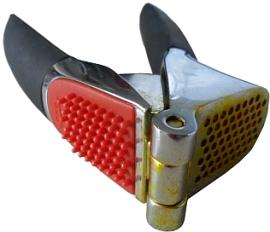 |
Spend a bit more and get a good one - this one
is also used for crushing fresh turmeric root. |
Garlic press

 I have used cheap garlic presses, basic garlic presses and then this one.
I have used cheap garlic presses, basic garlic presses and then this one.
It is die-cast metal, finished in chrome with rubber handles and a nice little device (the red plastic thing) that pushes back through the holes, anything that hasn't made it to the other side.
Whilst this might seem like overkill, it is very good and where other presses bend or are difficult to clean out, this carries on and gets the job done.
* Can't get it? - If you can't get a garlic press like this then slice and crush the garlic with a knife instead.
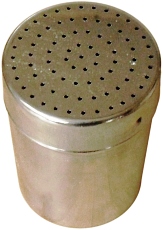 |
Sprinkling flour accurately is so
much easier with one of these. |
Flour shaker

 Whilst this is largely a luxury, there are times when you need to add a thin, even layer of flour, without adding too much, such as with double-spiralled spiral paratha, that is where this comes in.
Whilst this is largely a luxury, there are times when you need to add a thin, even layer of flour, without adding too much, such as with double-spiralled spiral paratha, that is where this comes in.
This shaker was supplied with a plastic lid that fits very tightly over the top, so that you can leave flour in it without it being attacked by the air.
Wholemeal flour has natural oil in it which is oxidised by the air and when that happens, it tastes bitter - this is why you should not buy more wholemeal flour than you are going to use in three months.
However, unless you are going to use this shaker every week, I would suggest that you don't put too much flour in it when you use it and that you put that flour back with the rest - assuming that you haven't back-contaminated it somehow - and clean it out and dry it well.
* Can't get it? - If you can't get a flour shaker then just pick up a bit of flour and sprinkle it on instead.
Mortar and pestle

 The mortar is the bowl and the pestle is the thing with the handle.
The mortar is the bowl and the pestle is the thing with the handle.
Whilst these are good at grinding things, there are some things that you will have more problems with than others.
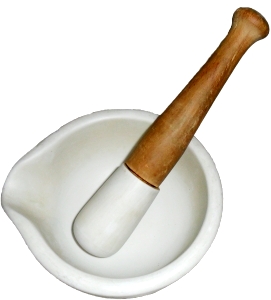 |
A good mortar and pestle will last you
for a long time so make it a good one. |
Things that are soft or rubbery such as cardamom seeds or pistachio nuts are soft and will tend to skid around the inside. One solution to that is to add something that will make it stick to the sides. When sugar is crushed, it makes little jagged-edged shards that grip the side of the mortar and the cardamom seeds.
Other problems are caused by things suddenly breaking and because you have been applying a lot of force to get it to break in the first place, the pestle will accelerate towards the mortar and hit it at a high speed with a lot of force as well, scattering anything that is in the way so, if you have something like that (cardamom pods, when you are getting the seeds out in the first place for example), cup your hand over the top.
Another problem is caused by light things that are brittle - saffron for example. These tend to break up with bits going everywhere so the solution to that is to do it slowly.
* Tip - Buy a good one and look after it.
* Tip - Put the mortar on a rubber mat so that it doesn't slip around the work surface - this will free up your other hand as well.
* Tip - If what you are trying to grind is skidding around the inside of the mortar and is destined for a sweet recipe, add some granulated sugar. It will hold it in place and help you do a good job. Finally, it is water soluble so will wash off the mortar and pestle well.
* Note - Note that a pestle with a wooden handle can have a problem later on it its life when the wood shrinks away from the inside of the porcelain part of the pestle. You can jam it with paper/card/wood, re-glue it and so on but be careful before you repair it because if you make repairing it a low priority once you have noticed that it is coming loose, it might come off.
* Warning - If you get one with a wooden handle, don't let it soak, forgotten about in water for hours waiting for you to remember to clean it, clean it straight away and dry it and put it away. Wood can expand and under some circumstances, break the pestle.
* Can't get it? - If you can't get mortar and pestle then use a chopping board and a rolling pin instead.
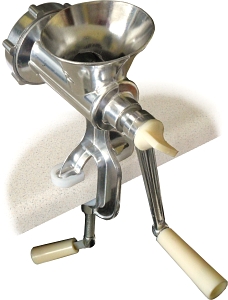 |
Cast aluminium alloy mincer -
these are nice and strong... |
Mincer
 chops up finely pretty much any vegetables and in bulk, deliver consistently divided, fine results, suitable for parthas and so on.
chops up finely pretty much any vegetables and in bulk, deliver consistently divided, fine results, suitable for parthas and so on.
The local cook shops tend to sell just plastic mincers, like the one on the left, which will creak and
 |
This is the plastic version - all right for
light work but don't count on it lasting long. |
groan if you put anything like ginger in them to mince.
I managed to get the one on the right from the Internet for less than half of what I paid for my plastic one.
Metal is stronger and more durable than plastic. It is less likely to pick up taints from what you are mincing in it. On the whole, metal is better.
Just in case you weren't paying attention to the last paragraph, don't get a plastic one, get a metal one instead. I got both and compared them so that you don't have to.
* Tip - Buy a good, metal one and look after it. I bought mine online for around 8GBP. The plastic ones are usually quite expensive - around twice the price of the metal ones - and are built as though they are a toy for toddlers - being about as strong as you would expect for such a use. However, they are not toys and are quite capable of causing serious damage to fingers and the like.
* Tip - Use bulk quantities of things like chillies, coriander leaf and so on, wash them first, then prepare them (top and tail or whatever is appropriate) and then mince them. Finally, put them in a thin layer in freezer bags and freeze for later use.
* Warning - Potentially, a mincer is quite dangerous - the fact that the box for the one on the right said 'meat mincer' gives a clue. It is always better to use something that is not alive to push things into the mincer but it is not always possible. If you get your fingers too close, these mincers are quite capable of causing serious injury to them. Therefore, assuming that you are pushing things into the mincer, always turn the handle yourself. If you feel your fingers getting dangerously close, you can stop straight away. If someone else is turning the handle and your fingers get too close, you might not be able to warn them until it is too late - think what can happen to your fingers in two seconds.
Just to recap The person putting the food into the mincer is the person who turns the handle.
* Warning - Make sure that you can fix this firmly to your work-surface and that the handle can rotate freely when the mincer is in position.
* Can't get it? - This is not an essential so if you can't get a mincer then use a knife instead.
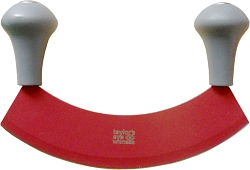 |
Mezzaluna - two handled, curved blade,
especially useful for chopping leaves. |
Mezzaluna (half moon) is a curved blade with two handles that you use to cut things like mint or coriander leaves.
(half moon) is a curved blade with two handles that you use to cut things like mint or coriander leaves.
Just put whatever it is you are cutting on a chopping board and use this knife, with a handle in each hand, rocking the blade back and forth, working your way along what you are chopping. Move your hands in a slight figure-of-eight motion to get it to do this. Practice makes perfect.
With a bit of practice, it is a lot faster than a normal knife and you can get better results as long as you don't overload the blade.
* Tip - Buy a good one and look after it.
* Tip - Put the chopping board on a rubber mat so that it doesn't slide around on the work surface - this is down to safety as well as convenience.
* Tip - Whilst it is ideal for cutting anything that is flat - such as coriander leaves - you can also use it for chopping up finely anything that you have already cut thin such as onions for including in paratha.
* Warning - This has one blade. You can buy these with two, parallel blades. Don't. When you eventually get around to sharpening it, you will not be able to grid the blade(s) perfectly (regardless of how many blades it has). With one blade, that doesn't really matter - unless you grind a really large flat on it. With two blades though, any change in the radius of one of the blades will either make it tilt or lead to a length of cutting edge that you are not using properly (because it isn't in contact with the board).
* Can't get it? - This is not an essential so if you can't get a mezza luna then use a knife instead.
Deep oil fryer Whilst not entirely essential - you could use a saucepan instead - a good deep oil fryer is particularly useful - AND SAFER.
Whilst not entirely essential - you could use a saucepan instead - a good deep oil fryer is particularly useful - AND SAFER.
This is the one that I use and I managed to get it from my local supermarket (ASDA). It is an own-brand one, holds 3 litres and it was only GBP25.
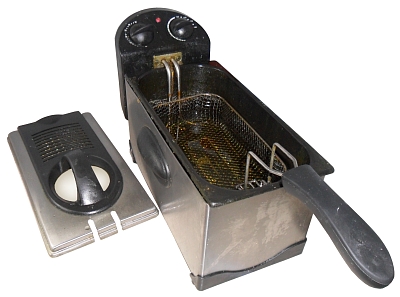 |
This fryer is inexpensive from your local supermarket (ASDA
in this case) and it has a timer that switches off the heat. |
There are a number of important characteristics with a deep oil fryer that make it safe and easy to use...
- a timer that switches off the power
- a thermostat that is calibrated (and in Celsius)
- a lid that can be put on when the fryer is in use
- a basket that drains into the oil
- to clean it, it dismantles into its various components - tray, basket, outer jacket, lid, heater/control unit.
There are a number of important things that you shouldn't do with a deep oil fryer...
- Don't over fill it with oil - the space above the oil is important to allow a certain amount of bubbling without overflowing and also, the basket cannot be raised completely out of the oil if there is too much oil in the fryer.
- Don't over-fill it with food - when you lower the basket into the oil, it will bubble up and if there is too much in the basket, it might well overflow. If you do find it bubbling up too high, raise the basket out of the oil and either take some of the contents out or lower it in gradually, controlling the bubbles.
- Don't use an oil that is not suitable for deep frying - some oils have too much water in them and that makes them unsuitable.
- Don't put water in it - it will sink to the bottom and, as its boiling point is lower than the temperature of the oil, it will bubble violently, splashing hot oil out of the fryer, possibly over anybody close to it.
* Tip - If you are using a fairly loose batter in small pieces - such as when you are making boondi - you can line the bottom of the basket with aluminium foil to stop it from sticking.
* Warning - In the UK, there are roughly 12,000 chip pan fires each year, of which just over a thousand are considered serious. These result in roughly 100 injuries per week and one death per week. Deep oil fryers are a lot safer because they are thermostatically controlled although that doesn't stop people doing stupid things with them.
* Warning - It is quite easy to describe one of these in a way that makes it sound insanely dangerous. Essentially, you are taking several litres of combustable liquid and heating it to close to its flash point (around 250C) - and then, as though that wasn't enough, you are placing in it, pieces of vegetables that have a lot of water in them and are dense enough to sink (oil has a density of around 0.9g/ml and water is roughly 1.0g/ml) so that the steam produced makes the oil bubble up, resulting in the oil level getting close to the top of the container. Think of it like that and you will better appreciate the hazards involved.
* Can't get it? - If you can't get a deep oil fryer then use a saucepan instead. However, you cannot leave fryers on their own - they will burn your house down.
 |
This will blend quantities too
small for a normal blender. |
Hand Blender This is not essential but when it comes to grinding up medium quantities of ingredients such as mango or onion, the alternatives are just too daunting.
This is not essential but when it comes to grinding up medium quantities of ingredients such as mango or onion, the alternatives are just too daunting.
If you have something that needs dividing up extremely small, such as onion, mango or apple when you are making chutney, you have a problem.
The quantity you are making is too small to go into a conventional liquidiser - the blades hit it when they start up and it then just sticks to the side - and what you are grinding is too slippy to go in a mortar and pestle with smooth sides - it just slides all over the place and doesn't grind.
One alternative it so put what you are grinding on a rough surface that will grip it and then sweep a straight blade over it at a shallow angle so that it grinds it up. The problem with that is that if you want to make a good job of it, you are going to get through only around 200g per hour so it is pretty impractical.
A hand blender like this will blend small quantities - such as 100g of chutney ingredients - very quickly.
It is easy to clean and very cheap - this one was less than GBP5 from the local supermarket.
* Can't get it? - If you can't get a hand blender then the alternative is to grind it using a textured surface and a straight edge such as a long knife or the flat end of something that is easy to hold - some rolling pins have flat ends. It is best to source a hand blender instead, or just not make what requires one until you can source one.
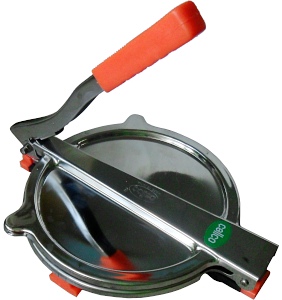 |
A puri press is designed specifically for doing
this and similar jobs. It is quick and easy. |
Puri Press This is certainly not an essential but a puri press makes the job of producing large quantities of medium-sized, round, thin pieces of dough, very quick and easy.
This is certainly not an essential but a puri press makes the job of producing large quantities of medium-sized, round, thin pieces of dough, very quick and easy.
The plates are around 5" in diameter and it is extremely easy to use.
Using plastic sheet so that separating the pressed dough from the press is easy, just place a small ball of dough on the press, put the lid down and depress the handle.
* Can't get it? - If you can't get a puri press then either improvise with a saucepan on the work surface or some other sort of press that you might have, or, failing that, use a rolling pin instead.
 |
This Roti Jala mould is perfect for the
job, just very difficult to obtain. |
Roti Jala Mould
 Making Roti Jala really needs the correct tool for the job although it is possible to improvise.
Making Roti Jala really needs the correct tool for the job although it is possible to improvise.
This is perfect. It is made from a flexible polymer and cast to a high standard so it works well and will last a long time.
To make Roti Jala properly, the batter needs to flow fairly uniformly but at least at a flow rate that prevents beading of the batter before or when it hits the hot tava. This tool has the holes at the bottom of a number of stems that mean that the volume of batter that would not produce good results is not there - all of the batter produces a good result.
However, these are particularly difficult to obtain. I managed to track down a supplier online and whilst cheap - only around GBP2.00 or so - it had to come all of the way from Malaysia. Not as much of a problem for people in south east Asia.
* Can't get it? - If you can't get a real Roti Jala mould, you can make one from things that you can find.
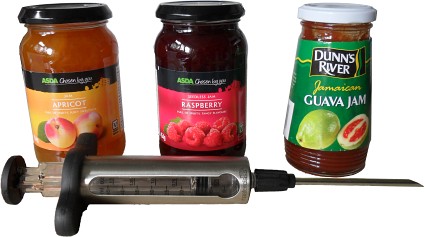 |
Jam syringe and a pick of smoother
jams - no seeds or chunks. |
Jam Syringe This syringe has two needles of different diameters and is really meant for injecting stuff into meat to give the impression that you spent more on it than you did (or something like that).
This syringe has two needles of different diameters and is really meant for injecting stuff into meat to give the impression that you spent more on it than you did (or something like that).
Our use for it is to inject jam into doughnuts so the larger of the two needles is the better option - a jam that is fluid enough to go through the thinner of the two will probably just disappear into the spongy interior of the doughnut instead of remaining as a blob.
* Warning - These are designed for injecting stuff into meat and as a result, are extremely sharp. Handle with care.
* Can't get it? - If you can't get a syringe like this then experiment with icing bags instead.
 |
A powdered cheese sprinkler
- ideal for making boondi. |
Sieve for making boondi
 For making boondi, you need something that can hold around 50mls or so of batter and has holes in it that are around 3-4mm in diameter.
For making boondi, you need something that can hold around 50mls or so of batter and has holes in it that are around 3-4mm in diameter.
There are draining ladles and other similar things but this is ideal. It has the word parmesan written on the side of it which sort of gives away its original intended use.
With anything that you use for making equal sized droplets, you need to make sure that the underside of it repels what you are making droplets of.
In the case of boondi, you need to smear a little oil on the underside of this before you put the batter in it and, afterwards, before the next batch, clean it with water and re-oil again.
* Can't get it? - If you can't get a powdered cheese sprinkler then use a draining ladle instead.
 |
Virtually nothing sticks to this,
making it ideal for many uses. |
Silicone rubber mat These are ideal for making anything that needs rolling - it acts like an extra pair of hands because it is thick enough - and also, anything that needs to be made, avoiding sticking to the surface.
These are ideal for making anything that needs rolling - it acts like an extra pair of hands because it is thick enough - and also, anything that needs to be made, avoiding sticking to the surface.
They are soft, heat resistant, thick silicone rubber mats and are ideal for sushi if you can't get hold of the real thing.
* Tip - Keep these in a drawer, well protected and never cut anything on them or get a knife anywhere near to them.
* Can't get it? - If you can't get silicone rubber mat for rolling sushi then use a bamboo sushi mat instead.
 |
Virtually nothing sticks to this,
making it ideal for many uses. |
Bamboo sushi mat These are made from bamboo and are sold for around GBP1.00 in the Chinese supermarket - you can probably get them elsewhere as well.
These are made from bamboo and are sold for around GBP1.00 in the Chinese supermarket - you can probably get them elsewhere as well. |
Virtually nothing sticks to this,
making it ideal for many uses. |
For the reason that it is made specifically for making sushi, it is ideally suited to that job - without wanting to sound too obvious, it is just that this is perfect in that you are not having to make something do a job for which it was not designed.
Simply place the sushi nori on the mat, use the bamboo spreader to get the rice just right, put in the filling and roll it up.
It couldn't work better.
* Can't get it? - If you can't get a bamboo sushi mat then a silicone rubber mat will do instead.
 |
Spaghetti spoons are good for
retrieving food from hot, deep oil. |
Spaghetti spoon

 The humble spaghetti spoon is particularly useful for retreiving from deep oil, things such as samosas, pakora, bhaji and so on.
The humble spaghetti spoon is particularly useful for retreiving from deep oil, things such as samosas, pakora, bhaji and so on.
* Can't get it? - If you can't get a spaghetti spoon then use one or two forks, or a different type of draining spoon instead.
 |
Electronic scales that measure down to the
gramme - how did you manage without? |
Electronic scales These were cheap from the local supermarket and will measure up to five kilogrammes with a resolution of one gramme.
These were cheap from the local supermarket and will measure up to five kilogrammes with a resolution of one gramme.
Putting a pot on these to measure in a few grammes of something becomes a reality (don't put hot things on it and be careful about scratching the surface).
* Can't get it? - If you can't get one of these then use a conventional spring balance instead - those are cheap but prone to stick..
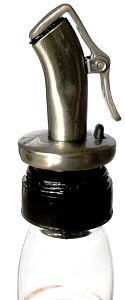 |
Oil spouts are worth getting
when you manage to source them. |
Oil spout An oil spout for a bottle is particularly useful - especially when you are doing a lot of fried items.
An oil spout for a bottle is particularly useful - especially when you are doing a lot of fried items.
Being able to get just the right amount of oil on a tava is a great deal easier with one of these.
* Can't get it? - If you can't get an oil spout then use your thumb over the end of the bottle instead - it is messy but it works.